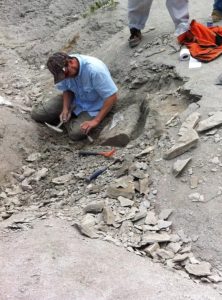
From the November 2017 Desktop News | Drs. John Abbott and Dana Ehret of UA Museums have been awarded $23,000 from the Institute for Museum and Library Services (IMLS). The grant, from the highly competitive “Museums for America” program, will allow them to move forward with the rehousing and digitizing of the UA Museums’ invertebrate paleontological collection.
“Many of these specimens are still housed in the containers they were originally collected in over 100 years ago (such as cigar boxes) and their data labels are faded, have insect damage, and are very fragile,” Ehret, curator of paleontology, explained. “It is extremely important to capture the data off of those pieces of paper before it is lost completely. This grant will allow us to house the specimens in proper archival containers, which will preserve them for future research, as well as allow us to catalog and digitize the collections. Specimens range from 500-million-year-old trilobites to 80-million-year-old starfish. Some of the earliest specimens in the collections were originally collected by Alabama’s first state geologist, Michael Tuomey, in the 1840s.”

A separate initiative is in place to take all of this information and make it accessible online as well, Ehret said. “This grant will aide in getting the paleontological collections in this new database,” he explained. “Researchers and amateur paleontologists will be able to go online and look at our holdings and even see pictures of specimens. In turn, it will lead to more research being done on our invertebrate paleontology collections and more collaborations with other researchers.”

Abbott, chief curator and director of museum research and collections for UA Museums (which contains some 3 million specimens and objects), said that the grant will allow UA Museums to more responsibly steward the specimens under its care. “We are always striving to take the best care of the objects and specimens we are charged with,” he said. “Rehousing the specimens in proper containers will not only better preserve them, but also make them more accessible to our staff and researchers. Digitizing the collection will do the same: By getting what we have online, researchers will know what we have and more easily be able to make loan requests or visit the collection in person to do research.”
This undertaking is not a small one and will take quite a while, Ehret said. “There will be three years of progress reporting to the IMLS. Most of the hands-on work will be done by myself as curator of paleontology, work study students, and volunteers,” he said. “The first step is planning. It is important to have a well-thought-out plan to keep the process moving in an organized manner. Because this grant money is primarily for supplies, I have already started the process of ordering supplies and working with a cabinet company to manufacture the drawers and shelves we will need. Each drawer of specimens that is in collections will be moved and sorted by myself with the help of work study students and volunteers. The specimens will be put into new boxes, trays, and vials; label data will be entered into our database; a catalog number will be generated for the specimen; the specimen and the label will be photographed for inclusion into the database; and then the cabinets will be re-filled by arranging the collections taxonomically.”